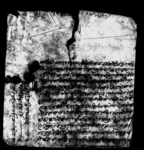A bond formalizing a money loan in which a slave has been put up as collateral (VS 1906)
ID: K_0348_0035
Edited and
translated by Manik Bajracharya
in collaboration with
Raju Rimal
Created: 2017-08-04;
Last modified: 2017-11-08
For the metadata of the document, click here
The accompanying edition, translation/synopsis and/or commentary are available under the terms of the Creative Commons Attribution-ShareAlike 4.0 International License
Abstract
This is a bond entered into by a debtor taking out a loan of 100 rupees and agreeing to pay his creditor two rupees interest per month during repayment. In the case of default, the creditor is entitled to take possession of the female slave Kāli aged 25.Diplomatic edition
[1r]
1श्री\1⟪4⟫1⟪४९⟫[fingerprint of Narāṃ Kaśna Pradhāna]1साछी[fingerprint of Muktinātha Jaisi]1वडहरेवश्नेमुक्तिनाथजैसि¯¯¯¯¯¯¯¯¯¯¯¯¯¯¯¯¯¯१[fingerprint of Vindā Ṭhakurni]1ऐंवश्नेविंन्दाठकुर्नि¯¯¯¯¯¯¯¯¯¯¯¯¯¯¯¯¯¯१[seal of Dalamardan Khatrī Kṣet]1[?]सुवेदारदलमर्दन्षत्रीक्षेत्¯¯¯¯¯¯¯¯¯¯¯¯¯¯¯¯¯¯१1स्वस्तिश्रीसम्वत्१९६२सालमितिमाघ२४गतेरोज३तसदि2नेलेषितम्धनिकानामचौतारावश्नेनरांकश्न•प्रधान
3वेहोरिनिकानामसिपावडहरेगाउवश्नेरामेश्वरजैसि
4गतलिहचादिकामोहरू१००अंकेपिये़कसये़कर्जालीय़ा
5वापत्साहुदेवनारांदुलाल्लाईतिर्नभनिलिय़ाकोसाचोहो
6सोरुपैयाकोनाफामैन्हा१कोमोह२रसाव़ास्मेतये़ही
7६२सालकाफागुनभरमावुझाउलासोधनकोधितोमे
8राघरकिकालिकमारीवर्ष२५किवंधकलेषिदिय़ाकोछु
9लेषिय़ाकाभाकामारूपैञावुझाउनसकिनभनेसोलेषि
10य़ाकीकालिकमारीपंचकिर्तिमोलमासुक्रिविक्रिग
11रीलिनुमेरोवेउजुरभनीमेरामनोमानषुसिराजीसंग
12तमसुकलेषिनिजसाहुलाईदिञाय़ोधनलीतमसुक
13लेषनाकासाछिफड्केपट्टिलेषिय़ाकासदरसुभ्म्¯¯¯¯¯¯¯¯¯¯¯¯¯¯¯¯¯¯
Synopsis
This is a loan document through which Rāmeśvara Jaisi, a resident of Sipā Vaḍahare Gāu, borrows 100 mohara rupaiyās at a rate of interest of 2 moharas1 per month from the creditor Narāṃ Kaśna Pradhāna, a resident of Cautārā. He borrows this amount to pay back a sum owed to the sāhuDevanārāṃ Dulāl. The debtor has drawn up tamasuka and puts a female slave named Kāli up as collateral. According to the document, if the debtor is unable to clear the debt with interest by the end of the next month, Phālguṇa, the creditor can sell the slave to recoup his money. The document is dated Tuesday, the 24th solar day (gate) of the month of Māgha of the [Vikrama] era year 1962 (1906 CE).
The witnesses to this document are: Muktinātha Jaisi, Vindā Ṭhakurni and SubedāraDalamardan Khatrī Kṣet.
Commentary
The slave Kāli mentioned here also appears in a document written three years later, K_0348_0037, through which she was sold along with her three children.

